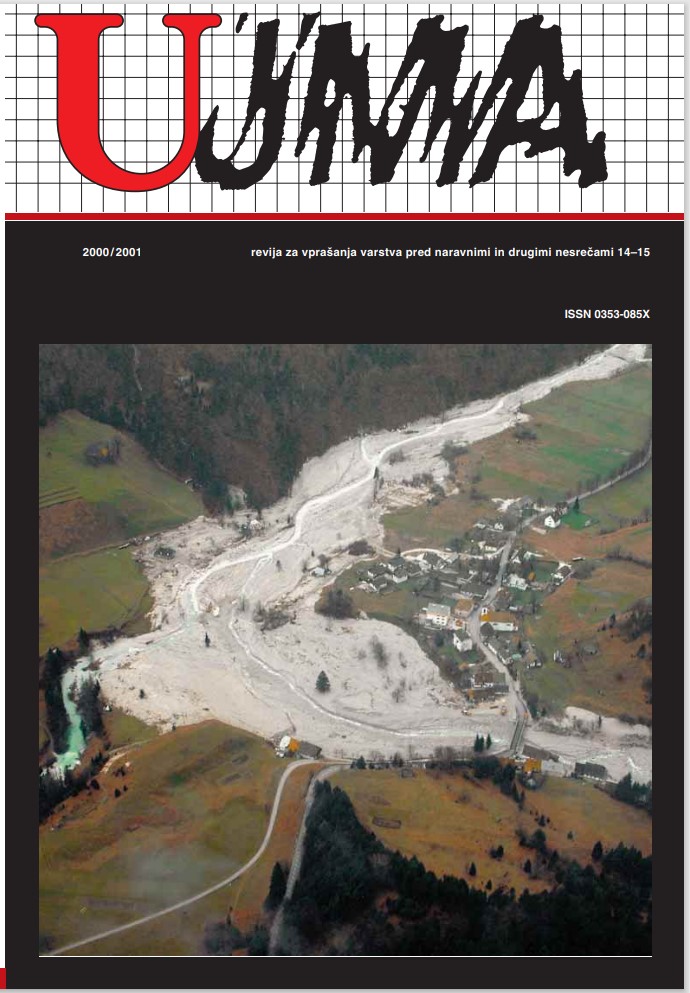CHARACTERISTICS OF DEBRIS FLOWS
Abstract
Debris flows are becoming an increasingly more dangerous hazard in mountainous regions of the world; this may also be due to climate changes. Debris flow can be described as a rapid movement of earth masses or debris with significant water content due to gravity forces. The possible causes of debris flow initiation are: land sliding down slopes, erosion of landslide deposits on steep valley bottoms or in stream or torrent channels, erosion and washing of bare soils, or a combination of these. A debris flow can erode a valley bottom or a stream channel and its banks, and transport huge amounts of sediments. In a stream channel through which a debris flow has moved, a well-defined erosional scar between the channel and the untouched slopes can be observed. Debris flows can be classified according to their mode of movement into three distinct regimes: the macro-viscous regime, transitional regime and the inert regime. For modelling of debris flows, different one- and two-dimensional mathematical models have been developed and relatively successfully used for real case studies. Nevertheless, utmost caution should be used when applying them, because actual situations in nature are often much more complex than those assumed in mathematical two-phase models. The main cause of the large landslide in Stože above the Mangart alpine meadows and the subsequent debris flow, which occurred just after midnight on 17 November, 2000, claiming 7 deaths and causing large material damage in the area of the alpine village of Log pod Mangartom, was the unfavourable geological setting of the slopes built of clayey talus debris overlaying morainic material. This slope ruptured after a long-lasting period of rain in the autumn of 2000 (more than 1600 mm of precipitation between 1st September, 2000, and 31 November, 2000). As a consequence of the high potential energy of sliding masses which have their failure scar at an elevation of 1600 m.a.s.l., and an intensive, short period of rainfall (showers) in the period between November 14th and November 17th, this landslide changed into a debris flow which travelled several kilometres and for several hours, reaching the Koritnica River valley 1000 altitude meters lower and devastating the alpine village of Log pod Mangartom.
References
Armanini, A., Michiue, M., (urednika), 1997. Recent Developments on Debris Flows. Lecture Notes in Earth Sciences 64, Springer Verlag, Berlin, 226 str.
Brilly, M., Mikoš, M., (c)raj, M., 1999. Vodne ujme: varstvo pred poplavami, erozijo in plazovi. Univerzitetni učbenik. Univerza v Ljubljani, Fakulteta za gradbeništvo in geodezijo, 186 str.
Chen, C. – L., (urednik), 1997. Debris-Flow Hazards Mitigation: Mechanics, Prediction, and Assessment. ASCE, New York, 817 str.
Coussot, P., 1997. Mudflow Rheology and Dynamics. IAHR/AIHR Monograph, A.A. Balkema, 255 str.
Embleton-Hamann, C., 1997, Austria. V: Embleton, C., Embleton-Hamann, C. (urednika), Geomorphological Hazards of Europe. Developments in Earth Surface Processes 5, Elsevier, 1–30.
Fakulteta za gradbeništvo in geodezijo, Jamova cesta 2, Ljubljana, mmikos@fgg.uni-lj.si
Gams, I., 1989. O terminologiji premikanja zemeljskih gmot. Geografski vestnik, 51, 171–176.
Jin, M., Fread, D.L., 1999. 1D Modeling of Mud/Debris Unsteady Flows. Journal of Hydraulic Engineering, 125, 827–834.
Mikoš, M., 2000. Izrazje na področju erozijskih pojavov. Gradbeni vestnik, 49, 102–114.
Mikoš, M., Fazarinc, R., 2000. Earthquake-induced erosion processes in two alpine valleys in Slovenia. Internationales Symposion INTERPRAEVENT 2000 – Villach, Tagungspublikation, Band 2, 143–154.
Scheuringer, E., 2000. Über die Anwendung von Modellen in der Wildbach- und Lawinenverbauung am Beispiel des Einödbaches in Rauris. Wildbach- und Lawinenverbau, 64, Heft 142, 77–84.
Steinwendtner, H., 2000. Simulation des Einödbaches/Rauris am Schwemmkegel bei Beaufschlagung durch einen Murgang. Wildbach- und Lawinenverbau, 64, Heft 142, 65–76.
Takahashi, T., 1991. Debris Flow. IAHR/AIHR Monograph, Balkema, 165 str.
Wieczorek, G.F., Naeser, N.D., (urednika), 2000. Debris-Flow Hazards Mitigation: Mechanics, Prediction, and Assessment. A.A. Balkema, Rotterdam, 608 str.
Downloads
Published
Issue
Section
License

This work is licensed under a Creative Commons Attribution-NonCommercial-NoDerivatives 4.0 International License.
The articles are made available to the public under Creative Commons Attribution-NonCommercial-NoDerivatives 4.0 International (CC BY-NC-ND 4.0).


